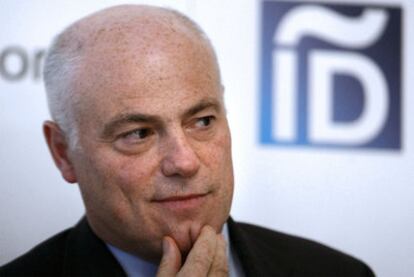Exports prop up Spanish economy at end of year
Government "comfortable" with growth forecast for 2011
The Spanish economy returned to the path of growth in the last quarter of the year driven by the export sector as domestic demand remained weak due to the government's austerity measures.
According to figures released Wednesday by the National Statistics Institute (INE), domestic demand made a negative contribution to overall output of 0.6 percentage points, while the positive contribution of net trade - exports minus imports - increased to 1.2 points from 0.9 points. Exports rose 10.5 percent, compared with an increase of only 5.3 percent for imports.
Consumer spending picked up the pace despite persistently high unemployment, growing an annual 1.7 percent in the final three months of the year after growth of 1.5 percent in the third quarter. But public spending took a turn for the worse, falling 0.9 percent after a decrease of 0.7 percent in the previous three months.
The government cut public sector wages last year by an average 5 percent, froze pensions and increased taxes, while slashing investment spending as it sought to trim its budget deficit to 6 percent of GDP this year.
The construction industry, one of the motors of strong growth for over a decade, remained in the doldrums with output falling 10.6 percent as the real estate sector struggled to recover from a slump.
The INE confirmed earlier flash estimates of quarter-on-quarter growth in GDP of 0.2 percent after no change in the third quarter and an annual increase of 0.6 percent. For the whole of last year, output shrank 0.1 percent, beating an initial estimate by the government of a fall of 0.3 percent. Spain emerged from its worst recession in decades at the start of last year.
The government has forecast GDP growth for this year of 1.3 percent, well above the International Monetary Fund's estimate of 0.7 percent.
"We are comfortable with our forecasts for this year," the secretary of state for the economy, José Manuel Campa, told a news conference on Wednesday. "We expect sustained growth in activity throughout 2011, sufficiently strong to bring about a recovery in employment in the medium term."
The INE said employment fell 1.4 percent last year, implying a net loss of 238,000 jobs. Spain's unemployment rate is double the European average at over 20 percent.
As well as having a devastating impact on employment, the crisis has also served to depress labor costs and purchasing power. "Salary-earners' income, the main resource of households for their spending needs, continued to fall as a result both of the fall in employment as well as average wages, which is having a negative impact on savings," the INE said.
Stagflation
The fall in unit labor costs accelerated to 2.3 percent in the fourth quarter. Inflation at the end of last year stood at 3.0 percent, its highest level in two years. This was accompanied by an increase in labor productivity of 2.0 percent.
Campa ruled out the possibility of Spain suffering from stagflation - weak output accompanied by inflationary pressure. GDP growth is "on the up," Campa said. "We don't see the possibility of stagflation under any scenario."

Tu suscripción se está usando en otro dispositivo
¿Quieres añadir otro usuario a tu suscripción?
Si continúas leyendo en este dispositivo, no se podrá leer en el otro.
FlechaTu suscripción se está usando en otro dispositivo y solo puedes acceder a EL PAÍS desde un dispositivo a la vez.
Si quieres compartir tu cuenta, cambia tu suscripción a la modalidad Premium, así podrás añadir otro usuario. Cada uno accederá con su propia cuenta de email, lo que os permitirá personalizar vuestra experiencia en EL PAÍS.
¿Tienes una suscripción de empresa? Accede aquí para contratar más cuentas.
En el caso de no saber quién está usando tu cuenta, te recomendamos cambiar tu contraseña aquí.
Si decides continuar compartiendo tu cuenta, este mensaje se mostrará en tu dispositivo y en el de la otra persona que está usando tu cuenta de forma indefinida, afectando a tu experiencia de lectura. Puedes consultar aquí los términos y condiciones de la suscripción digital.








































